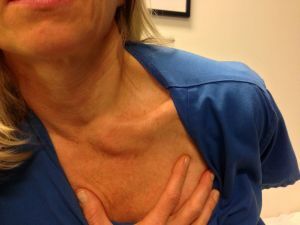 Clavicles are a pair of long bones that connect the scapula to the sternum. The name of the collarbone is derived from the Latin word "key".The clavicle is one of the bones that is most often damaged in the human body.
Clavicles are a pair of long bones that connect the scapula to the sternum. The name of the collarbone is derived from the Latin word "key".The clavicle is one of the bones that is most often damaged in the human body.
Clavicles are cylindrical bones 15 cm long, bent in the transverse plane, like the letter S. They are located in the thoracic upper section and are attached to the first rib.
Each clavicle extends laterally and forms a connection to the sternum on its medial end and a scapula at its lateral end.
The unique position of the clavicle in the body often leads to dislocations and fractures, more often due to traffic accidents.
When the hand is stretched during the injury, most of the force from the fall is transmitted through the arm to the shoulder, which leads to a sudden displacement and can break the collarbone.
When strong force is applied directly to the shoulder, for example during a car accident or during a sudden fall, the bones of the shoulder may be sprained medially and lead to a dislocation or fracture of the clavicle. It is worth noting that a fracture of the clavicle occurs much less often than a dislocation.
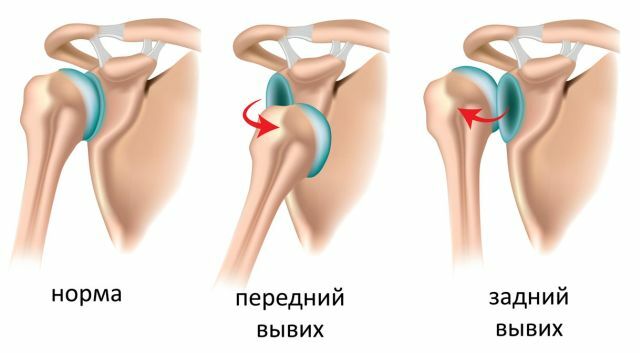
Contents of the article
- Types of dislocations of the clavicle
- Types of dislocation of the clavicle
- The nature of the
- trauma
- trauma
-
-
- to sport - from 5 months to a year
-
- Types of dislocation of the clavicle
Varieties of dislocations of the clavicle
Based on the scientific classification, dislocation of the clavicle can be divided into three types, each of which has aeobraznye features. Let's consider in more detail each of them.
There are three types of dislocation of the clavicle:
- Dislocation of the acromioclavicular joint .This species is most common. It occurs most often as a result of a fall on the
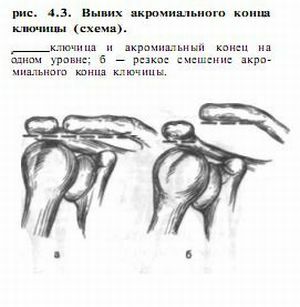 shoulder, when the ligaments are torn apart within the peripheral part of the clavicle. It is characterized by protrusion of the clavicle and some deformation of the shoulder region. It should be noted that the acromioclavicular joint has a relatively low mobility.
shoulder, when the ligaments are torn apart within the peripheral part of the clavicle. It is characterized by protrusion of the clavicle and some deformation of the shoulder region. It should be noted that the acromioclavicular joint has a relatively low mobility. - Dislocation of the sternal end of .Occurs when a person falls on a withdrawn hand( indirect trauma).This kind of dislocation distinguishes between two subspecies: anterior and posterior. The most common anterior dislocation, with the sternal end of the clavicle shifting to the anterior margin.
- Simultaneous dislocation of the clavicle joint .This is the most dangerous damage to the bone, when both the acromial end and the sternal end of the joint are damaged during the injury. Such a trauma is considered dangerous for human health and is often difficult to treat.
Due to any dislocation, it is difficult for a person to manage a damaged limb. Movements become difficult and painful.
Dislocation of this bone occurs several times more often than fractures. In the risk group there may be both young people and elderly people( from 17 to 60 years old).
What are the causes of the
injury? The clavicle can be damaged due to two mechanical effects on it: an indirect and direct effect.
With direct trauma, the acromial part is affected from the bottom up. This happens when you fall or hit hard. In such situations, the bone goes back, resting on the first rib. Indirect mechanical impact is characterized by a fall of a person on the shoulder.
Traumatologists identify several main causes, which most often lead to dislocation of the clavicle. For these reasons it is possible to attribute: 
- blow to the thorax;
- a strong blow directly to the collarbone( can occur during an accident);
- fall on the humerus.
The most common damage to this bone is observed in such a group of people:
- gymnasts;
- basketball players;
- volleyball players;
- older people( over 50 years);
- patients with osteochondrosis.
Collarbone damage can be of varying degrees. The clavicular ligaments may be damaged, the capsule may be ruptured. If the damage was significant, the muscles attached to the bone are torn( deltoid and trapezoid).
Features of the clinical picture
The main pain in the case of a clavicle dislocation falls on the junction of the clavicle and scapula. A person feels pain while stirring with his arm or shoulder. In addition, it is impossible to withdraw or raise your hand up. There may be a bruise or swelling.
With acromial dislocation, deformation of the bone itself is observed: its acromial end will bulge upward and slightly back.
At the same time, the characteristic sign of a clavicle fracture is the "key symptom".This is when, when pressing on the part that protrudes, it is observed that the bone is in its place.

On the photo of the dislocation of the acromial end of the right clavicle
After stopping the pressure, the acromial end of the clavicle is again lifted upward. It is worth noting that this characteristic in most cases is simply impossible to determine, as when pressing on the damaged area the patient experiences unbearable pain.
Full people can be difficult to diagnose, as the collarbone will be poorly palpated.
The most reliable method of diagnosis is the X-ray of the damaged bone.
The most common clavicle dislocation symptoms:
- severe pain in the clavicle and in the shoulder girdle;
- decreased sensitivity of the shoulder girdle and upper limb;
- severe pain when trying to move a hand;
- marked deformations of the joints in which the clavicle is connected to another bone;
- tenderness of the skin biased joint;
- edema and hematomas in the area of dislocation;
- insensitivity or paralysis of the damaged limb( this can be caused by pressure of nerves and vessels).
Any damage to the clavicle should give you a signal that you need to see a doctor as soon as possible. Try not to eat before you go to the doctor.
Solid food increases the likelihood of vomiting when reconstructing a dislocation, especially if the direction is made using anesthesia.
First aid for the injured
If there is a suspicion of a clavicle dislocation, the injured limb should be suspended with a bandage that will be thrown over the neck. Under the axillary region, you need to put a roller( this can be rolled up clothing).
If there is swelling or the hand begins to turn blue, then it is advisable to apply a cold compress to the place of injury( something from a refrigerator or a bottle of cold water).Next, you need to call an ambulance or take the injured person yourself to the trauma clinic.
Do not also give painkillers medications - this may make further examination difficult. Extreme cases can be unbearable pain that can not be tolerated.
Trauma treatment
As a rule, physical examination is sufficient to assess the degree of damage. To confirm the diagnosis 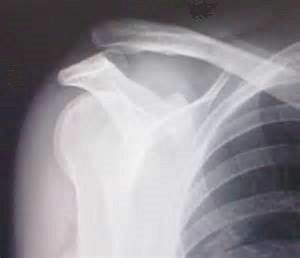 will need to take an X-ray. He does not show if the ligaments are damaged, but will show the degree and direction of movement of the clavicle and the possible fracture of the bone.
will need to take an X-ray. He does not show if the ligaments are damaged, but will show the degree and direction of movement of the clavicle and the possible fracture of the bone.
Injury of the first degree is treated conservatively. It is recommended to rest, applying ice to the damaged area, using analgesics and applying a bandage, since the main task is to correctly fix the position of the bone.
The most severe case, when there is a dislocation of the clavicle with a rupture of ligaments. In such situations, it may be necessary to promptly intervene.
Conservative treatment in this case generally yields satisfactory results for patients, but this is for those people who are not associated with professional sports for athletes. Surgical treatment will bring discomfort during a heavy load.
The treatment period is from 4 to 6 weeks. If an operative intervention was prescribed, then the therapy lasts at least 6 months. After that, the victim will have to undergo a course of rehabilitation.

If the injury is chronic, in this situation only surgery is used. Most often, an operation is performed using the method of Bohm, Bennel, Watkins-Kaplan. The purpose of the operation is to create a bundle of synthetic materials. After 6-7 months, the full capacity of the limb is restored.
In order to prevent injury to
The main preventive methods are the complete prevention of any injury to the upper extremity belt.
In case of any damage, immediately consult a doctor to prevent complications and start treatment on time.
If you have already had a dislocation of the clavicle, then you will need to perform physical exercises on a regular basis, which the physiotherapist will appoint. This will help strengthen the ligaments and muscles, they will become more elastic and prevent dislocation will be much easier.
In order to get in shape as soon as possible, it will take several months of rehabilitation. To strengthen muscles and ligaments, as well as for correct fixation, the doctor will prescribe elastic bandages. When the time passes, and the hand will need to be developed, there are special exercises for this.
Rehabilitation process
Recovery after an injury takes place in several stages.
Step 1 - duration 3 weeks
It is necessary to begin to perform exercises to strengthen the muscles of the shoulder girdle. The range of motion is small, painless. The permissible load on the shoulder joint should not cause pain.
The starting position for this exercise must necessarily include shoulder support. Circular motion of the shoulder region is performed. Do not inject combined movements with limbs, as they can lead to repeated trauma.
Movement is performed only when the pain is absent. Continue to wear an elastic bandage to support the upper limb.
Apply something cold( ice, for example) after exercise if swelling or swelling occurs.
Strengthening of the shoulder girdle - period up to 3 months
Based on active exercises for restoring the muscular function of the flexor of the shoulder, bringing the humerus. Here you can start to try push-ups from the hill( for example, from a chair or wall).
Do not rush to restore the full range of motion.
We return to the sport - from 5 months to one year
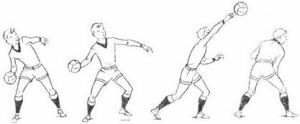 We use already dumbbells or other weighting agents. They are needed to strengthen the periarticular muscles of the shoulder joint.
We use already dumbbells or other weighting agents. They are needed to strengthen the periarticular muscles of the shoulder joint.
Begin to perform movements specific to your sport: throws( eg, a ball), jerks.
The load should be gradually increased, while controlling the technique of performing the exercises. Then enter the complex coordinated exercises. Avoid stretching the joint capsule, jerks.
Take care of yourself and your health!



